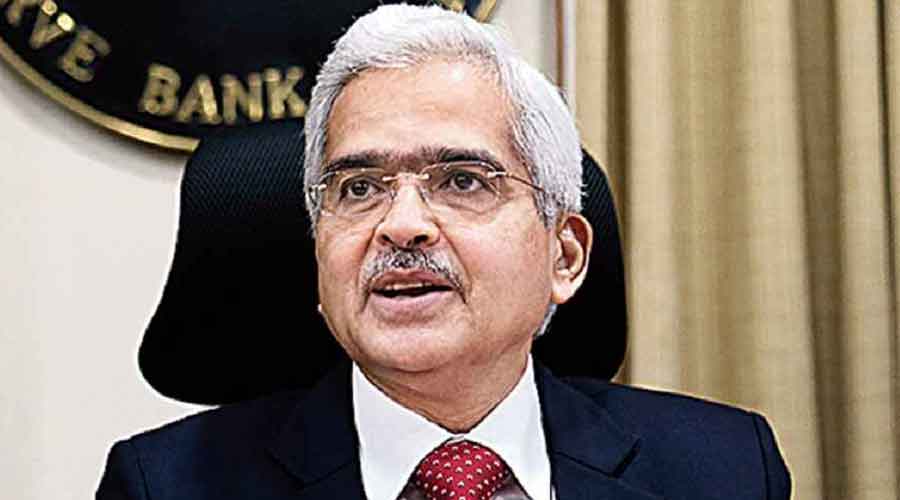The Reserve Bank of India on Friday kept the benchmark interest rate unchanged at 4 per cent and going forward decided to withdraw its accommodative stance to ensure that inflation remains within the target level.
Retail inflation is hovering above the RBI's upper tolerance level for the past couple of months. It was 6.07 per cent in February and 6.01 per cent in January, mainly due to an uptick in food prices.
This is the 11th time in a row that the Monetary Policy Committee (MPC) headed by RBI Governor Shaktikanta Das has maintained the status quo. The central bank had last revised its policy repo rate or the short-term lending rate on May 22, 2020, in an off-policy cycle to perk up demand by cutting the interest rate to a historic low.
The MPC, based on its assessment of the macroeconomic situation and outlook, voted unanimously to keep the policy repurchase (repo) rate unchanged at 4 per cent, Das said while announcing the bi-monthly monetary policy review.
The committee also decided unanimously to remain accommodative while focusing on withdrawal of its current stance to ensure that inflation remains within the target band going forward, he said.
Consequently, the reverse repo rate will continue to earn 3.35 per cent interest for banks for their deposits kept with the RBI.
Das further said the marginal standing facility, MSF rate and bank rate, remain unchanged at 4.25 per cent.
The RBI slashed the growth projection for the current fiscal to 7.2 per cent from 7.8 per cent earlier; while raising the inflation forecast to 5.7 per cent from 4.5 per cent.
The MPC has been given the mandate to maintain annual inflation at 4 per cent until March 31, 2026, with an upper tolerance of 6 per cent and a lower tolerance level of 2 per cent.
The bi-monthly policy comes against the backdrop of the Budget wherein a nominal gross GDP of 11.1 per cent has been estimated for 2022-23.
The government expects this growth to be fuelled by a massive capital spending programme outlined in the Budget with a view to crowd-in private investment by reinvigorating economic activities and creating demand.
Finance Minister Nirmala Sitharaman raised capital expenditure (capex) by 35.4 per cent for the financial year 2022-23 to Rs 7.5 lakh crore to continue the public investment-led recovery of the pandemic-battered economy. The capex in the current financial year is pegged at Rs 5.5 lakh crore.
The spending on building multi-modal logistics parks, metro systems, highways, and trains is expected to create demand for the private sector as all the projects are to be implemented through contractors.
Other highlights of RBI Monetary Policy Committee:
• Rationalisation of risk weights for individual housing loans to be extended till March 31, 2023, says the RBI governor.
• RBI sees Current account deficit at sustainable levels and forex reserves at $606.5 billion
• Held-to-maturity limit to revert to 22 percent of banks' net demand and time liabilities in FY24
• RBI also proposes panel to review status of customer service at RBI-regulated entities
• Cardless cash withdrawal to be made available at all bank branch and ATMs via UPI, to prevent frauds. To secure payment systems, propose guidelines for such operators
• BBPS has seen rise in volumes, to encourage this further, propose to reduce networth requirement for such entities to Rs 25 crore vs Rs 100 crore
• SDF, MSF will be available from 5:30 pm till midnight all days of the week. Money market opening time restore to 9:00 am, which is the pre-pandemic time.
• Financial markets were prepared for the LAF corridor over the past several months. We are introducing Standing Deposit Facility (SDF) to provide symmetry to the operating framework of monetary policy. RBI will introduce SDF as the floor for the LAF corridor. SDF to have 3.75 percent interest rate. Access to SDF, MSF will be at the discretion of the banks, Das said.
• RBI's extraordinary liquidity measures have left Rs 8.5 trillion overhang in the system
• RBI will now engage in a gradual, calibrated, non-disruptive withdrawal of this excess liquidity over a multi-year period
• CPI inflation seen averaging 5.7 percent in FY23. It is seen averaging 6.3 percent in April-June 2022; seen averaging 5.0 percent in July-September 2022; seen averaging 5.4 percent in October-December 2022; and seen averaging 5.1 percent in January-March 2023. Macroeconomic outlook going under tectonic shifts, must take preemptive steps.
• RBI to continue to adopt a nuanced and nimble-footed approach to liquidity management in India
• Normalisation of LAF corridor should not come as a surprise
• 10-year bond yield rises to 7%, the highest since 2019, says Shaktikanta Das
• RBI introduced Standing Deposit Facility to absorb liquidity
• MSF and Bank rates have also been unchanged
• Since the last meeting, the expected benefits of ebbing of Omicron offset by geopolitical situation. Are introducing a Standing Deposit Facility, which will form the floor of the Liquidity Adjustment Facility corridor. Projection of global inflation ratcheted up, risk of sizeable impact across geographies in global production. Cost pressure, supply chain disruptions likely to linger on, said RBI Governor Shaktikanta Das.
• Inflation projected at 5.7% in FY23, says Shaktikanta Das
• Real GDP growth for FY23 projected at 7.2%: RBI
• Escalating Russia-Ukraine war has cast shadow on economic outlook, says Shaktikanta Das
• Global economy has seen a tectonic shift, said Governor Das











